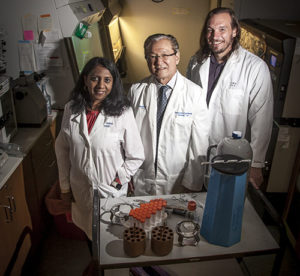![]() Every week, we do a little research of our own. We’re looking for scientists, professors, engineers, entrepreneurs—anybody, really—engaging in research and development across North Texas.
Every week, we do a little research of our own. We’re looking for scientists, professors, engineers, entrepreneurs—anybody, really—engaging in research and development across North Texas.
There’s plenty of good work being done. If you want to put R&D under your microscope, sign up for our e-newsletter.
UTSW and SMU learn how birds migrate in the dark
Most of us have seen migratory birds flapping their way along flyways back and forth in the spring and late fall, using the Earth’s magnetic field as a guide.

UT Southwestern Medical Center research specialist Yogarany Chelliah, Dr. Joseph Takahashi, and SMU’s Dr. Brian Zoltowski. [Photo: Courtesy SMU/Kim Leeson.]
It’s been suspected birds use a protein called cryptochrome that’s sensitive to blue light, but that doesn’t explain what happens at night. Well, scientists at UT Southwestern Medical Center and Southern Methodist University in Dallas appear to have figured it out.
The researchers discovered that migratory birds’ cryptochromes have evolved a mechanism that improves their ability to respond to light, enabling them to sense and respond to magnetic fields.
Found in both plants and animals, cryptochromes are responsible for circadian rhythms in various species. In birds, the researchers focused more on an unusual eye protein called CRY4, which is part of a class of cryptochromes.
Joseph Takahashi, a UTSW circadian rhythms expert, worked with other UTSW scientists to purify and solve the crystal structure of the protein. The lab of blue-light photoreceptor expert Brian Zoltowski studied the efficiency of the light-driven reactions, identifying a pathway unique to CRY4 proteins that facilitates function under low light conditions.
“We were able to show that the protein cryptochrome is extremely efficient at collecting and responding to low levels of light,” Zoltowski, who was one of the lead authors of the new study on the findings, said in a statement. “The result of this research is that we now understand how vertebrate cryptochromes can respond to very low light intensities and function under night time conditions.”
Find out more about the research here.
McKesson and TrakCel collaborate to support cell and gene therapy developers
McKesson Corp., the Irving-based pharma distribution giant, has announced a new collaboration with TrakCel, a software developer for cell and gene therapy supply chain tracking and orchestration systems.
The companies intend to collaborate on support for cell and gene therapy late-stage developers. The plan is to integrate both businesses’ supply chain tracking and patient access services to create a more efficient path for the development of next-generation commercial therapies.
With an integrated system, McKesson’s Layne Martin said prescribers and manufacturers will be able to seamlessly work together to ensure the right patient always receives the correct therapeutic product.
Read more about the collaboration here.
A UTSW study shows possible treatment for polycystic kidney disease
A drug that is a potential treatment for polycystic kidney disease has shown promising results in animal testing and now is in early clinical trials in humans, UT Southwestern Medical Center announced.
Polycystic kidney disease is a genetic disorder that causes the kidneys to swell with multiple cysts and can eventually lead to organ failure. According to UTSW, autosomal dominant polycystic kidney disease (ADPKD) affects around 12 million globally, with half developing end-stage kidney disease at age 60.
The only drug currently approved to treat ADPKD carries the FDA’s highest warning in its prescribing information, a box telling users of the possibility of “serious and potentially fatal liver injury.” The new treatment cooperatively developed at UT Southwestern and Regulus Therapeutics Inc., a biopharmaceutical company based in California, showed no evidence of toxicity in animals or in human cell tests, according to the study.
“Once the kidneys have failed, the only options for survival are dialysis or a kidney transplant,” said Dr. Vishal Patel, associate professor of Internal Medicine at UT Southwestern and senior author of the study. “A large percentage of ADPKD patients on dialysis die each year while waiting for a donated kidney.”
An SMU professor and Garland students crowdsource data on a bridge’s health
Bret Story, a professor at SMU, is working with students at Garland High School that literally bridges new technologies with structural engineering.
Story has been working with the high school students using the Briarwood bridge in Garland as a test bed for a new method of continuously monitoring bridges, The Dallas Morning News reported.
The team collects information via the smartphones in passing cars to check the bridge’s structural health. Story said he thinks this approach won’t be a substitute for regular bridge inspections, but it might make it safer and more efficient.
Bridge inspections, which usually occur every couple years or every six months if inspectors have concerns, often require the whole bridge to be closed.
If proven effective, Story said crowdsourcing information from smartphones could allow bridges to be monitored virtually all the time without stopping traffic.
![]()
Get on the list.
Dallas Innovates, every day.
Sign up to keep your eye on what’s new and next in Dallas-Fort Worth, every day.

































